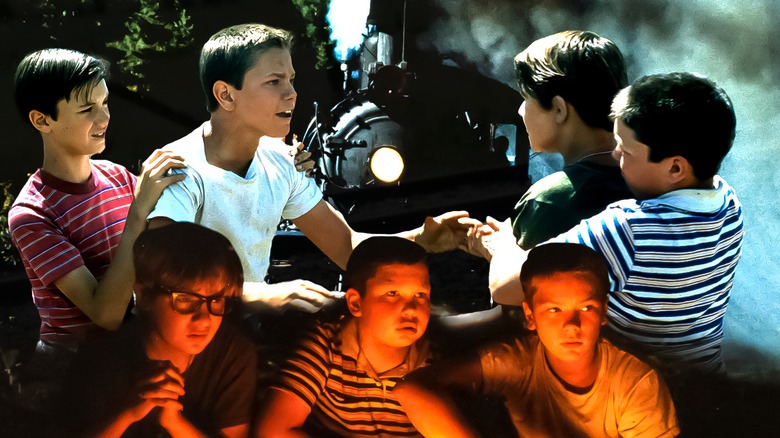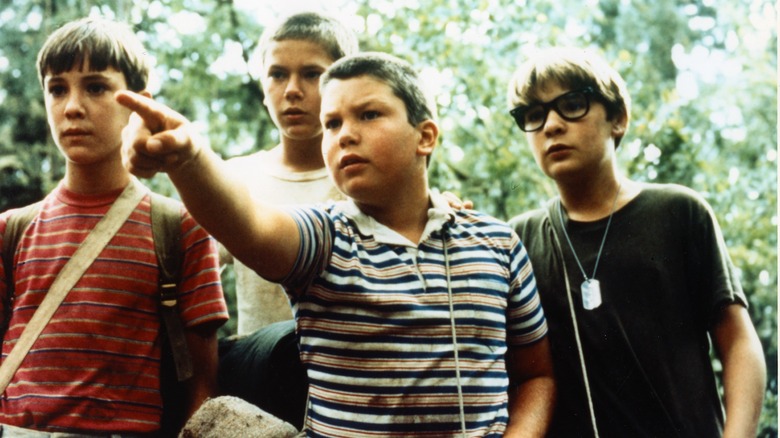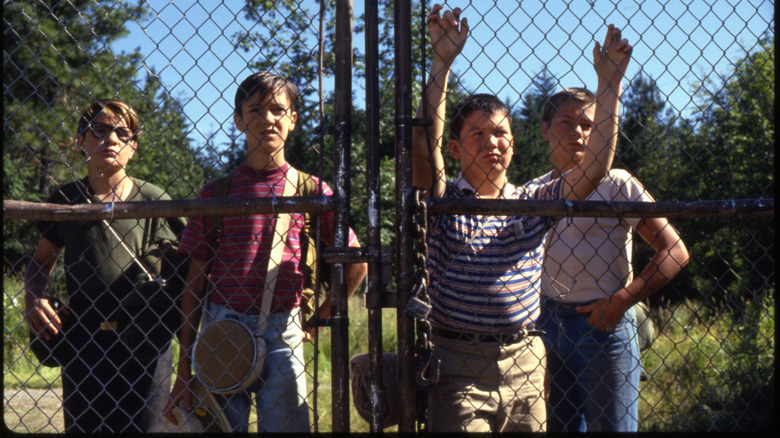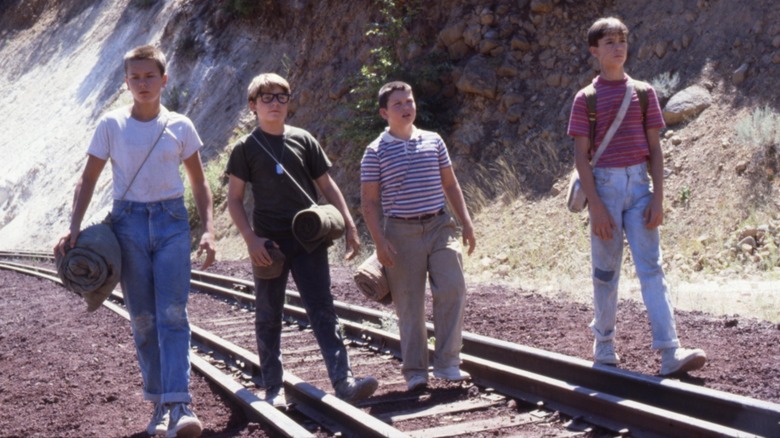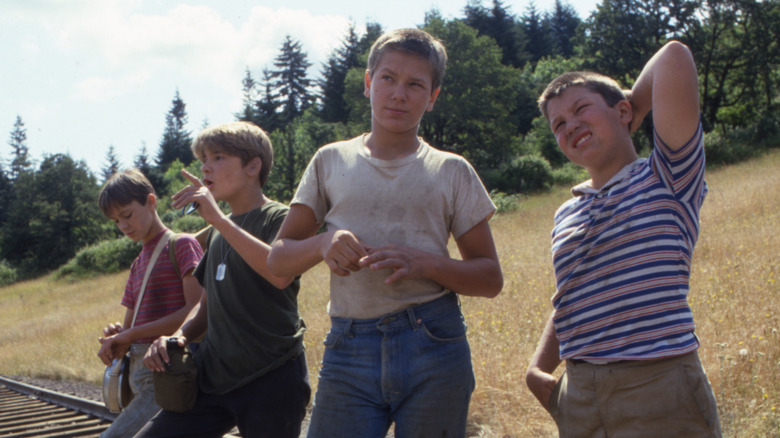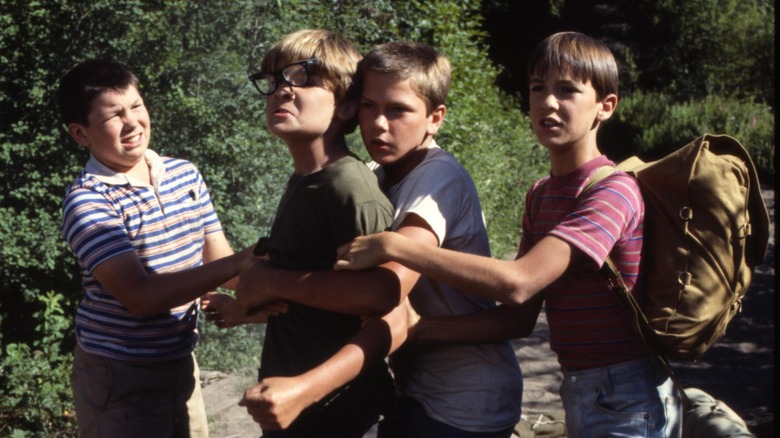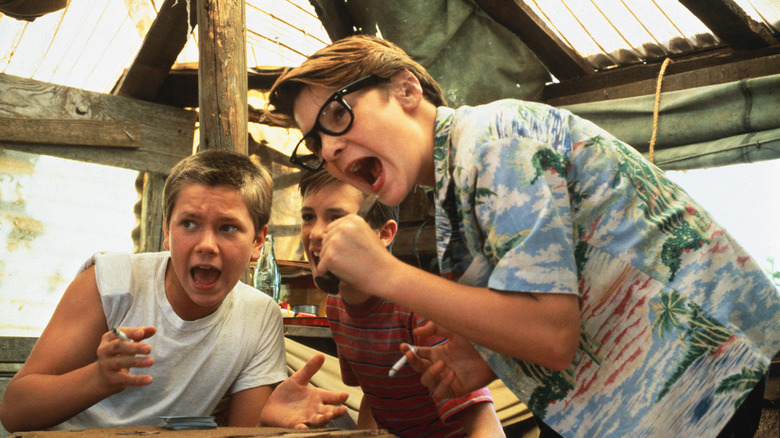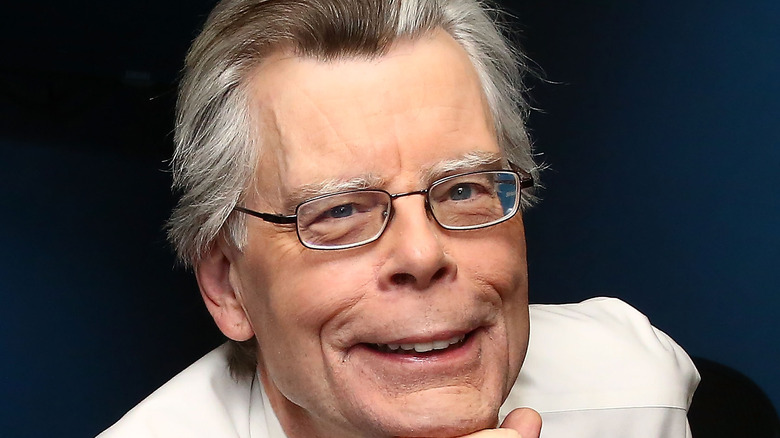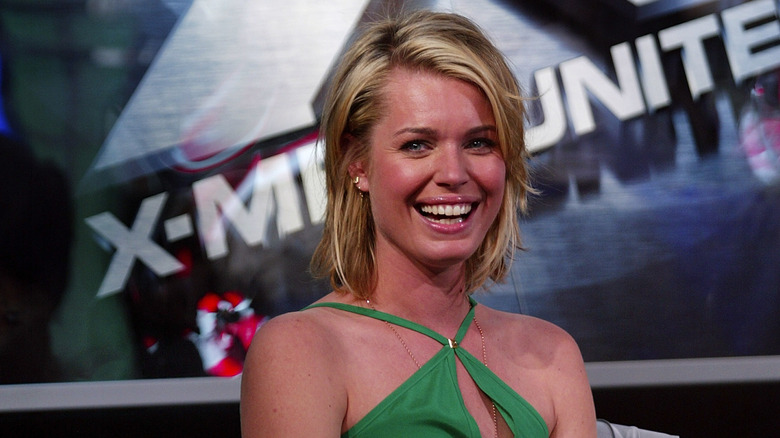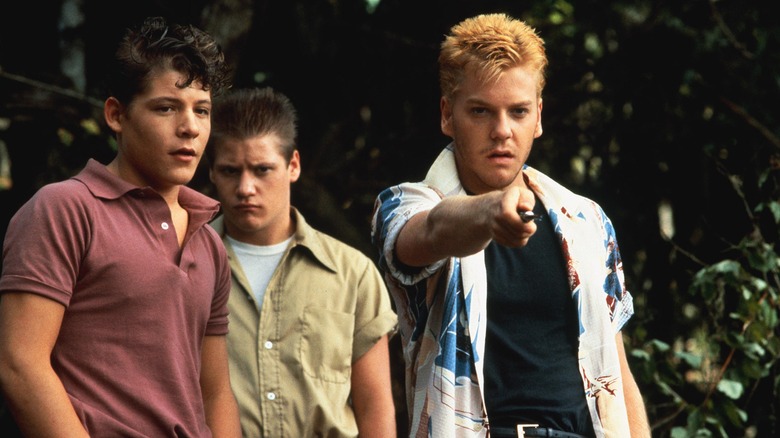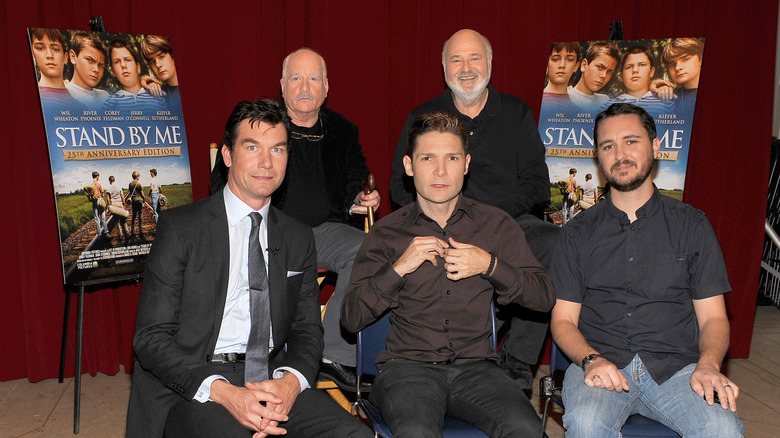Stand By Me Facts That Got Buried In Castle Rock
The promise of a big adventure into the unknown is never more alluring than when you're a kid. Experience has yet to numb you, reality has yet to disenchant you, and the world's promise and potential remain as seductive as a summer breeze. Director Rob Reiner's "Stand By Me" poignantly evokes that very same call of the wild, the wonder of youth, the fierce and unbeatable joy of being in a gang, and the creeping melancholy that all things under the sun must one day pass. Set in 1950s America, with all the intoxicating nostalgia and fever dreams that the decade conveys, "Stand By Me" is about the loss of innocence, the permanence of change, and four outsiders looking to find their place in the world. Released in 1986, it's a coming-of-age movie that sets the gold standard.
Based on Stephen King's novella "The Body," the four boys' quest to find the rotting corpse of missing boy Ray Brower is overshadowed by death and decay from the outset. Yet the film's power lies in the personal transformation that happens to the youngsters along the way as they attempt to keep one step ahead of the sort of psychopathic rockabilly teenagers not usually seen this side of a pulp fiction novel.
Although Gordie, Chris, Teddy, and Vern are four distinctly different personalities, what unites them is that they're all misfits from dysfunctional backgrounds who feel life's trials and tribulations as keenly as a razor blade. "Stand By Me" is their story, but it belongs to everyone who's walked in the twilight world between childhood and adulthood. Here are some facts that got left behind in Castle Rock.
The film was turned down by all the major studios
Universally adored by audiences the world over and considered a classic by critics everywhere, it's difficult to imagine any studio not giving "Stand By Me" the green light. But hindsight is a wonderful thing, and back in the day when the suits were presented with a script about a group of misfits in 1950s America looking for a corpse, they passed. Although director Rob Reiner would go on to direct further classics like "Misery," "When Harry Met Sally," and "The Princess Bride," back in the mid-'80s he was simply known as the guy who directed the cult classic "This Is Spinal Tap."
In an interview with Variety, producer and co-writer Bruce A. Evans explained, "Every studio in town had turned us down. The consensus was that no one would be interested in a story about four 12-year-old boys on a railroad track." Evans pointed out that because the central theme of "Stand By Me" is quite dark and there's no romantic sub-plot, studio bigwigs weren't sure how they could market it. By contrast, everyone committed to the film felt that a coming-of-age drama that didn't include first kisses or sex was its unique selling point. "It was about kids becoming aware of their own mortality," explained Evans.
Eventually, Embassy agreed to finance the film. As Evans put it, "Embassy at the time was the last station before the desert. After that there was nothing."
Coca-Cola almost pulled the plug on the film
Although Embassy Communications at first appeared like the light at the end of the tunnel for the team behind "Stand By Me," it was a false dawn. After going through a grueling series of auditions to find the right leads, with future stars like Ethan Hawke and Sean Astin passing through, Rob Reiner finally settled on River Phoenix, Corey Feldman, Jerry O'Connell, and Wil Wheaton. For Reiner, the sheer number of auditions makes it hard to recall all the hopefuls, but he told Variety, "I remember being incredibly moved by River when he came in to read for Chris Chambers." With a cast of extremely talented but relatively unknowns in place and shooting about to commence, disaster struck when the owners of Embassy decided to sell to Columbia.
As a subsidiary of Coca-Cola, Columbia had little time or inclination to fund a coming-of-age story with no romantic interest or household names. Three days before filming was to begin, executives pulled the plug. Reiner explained the entire cast and crew were in Oregon with purpose-built sets ready to go when they were told that the financing had run dry. "It was nerve-wracking because we had all these people up here and we've got nothing. We've got no financing," the director recalled. All looked lost until former Embassy co-owner Norman Lear decided to step in and use $7.5 million of his own money to finance the film. Despite lacking distribution or a video deal, Lear believed deeply in what Reiner was trying to do, and decided to take a punt.
Adrian Lyne nearly directed Stand By Me
Though "This Is Spinal Tap" had found a cult fandom, "Stand By Me" was Rob Reiner's breakthrough film. It showed the world what he was capable of behind the camera and launched his Hollywood career. Yet it could have been an altogether different story if "Nine and a Half Weeks" director Adrian Lyne had taken the director's chair. Reiner explained to Variety that Lyne was originally on board, but after exhaustion set in from his hectic schedule, he was forced to hand over the reins.
Reiner was sent the script to see if he'd be interested and although he developed an instant connection with the characters and the dialogue, he felt the film lacked focus. "I spent the next four days riding around Los Angeles, trying to think of a way to make it work," he said. "It was giving me headaches trying to figure it out."
Reiner's eureka moment came when he realized that the emphasis should be on Gordie and not Chris. Reiner explained that in the initial version of the script, Gordie was simply an observer and not the chief protagonist. He felt the change was needed because the film was about an insecure kid looking for something. "He's driven to go see this body because he never cried at his brother's funeral and his father always paid more attention to his older brother who died," explained Reiner.
Stand By Me is Stephen King's favorite movie adaptation
Ever since Brian De Palma successfully turned "Carrie" into a horror classic in 1976, the list of Stephen King movie adaptations has been growing exponentially. While the horror monarch is indifferent to many of them and actively loathes a fair few, some have won his tell-tale heart over, particularly "Stand By Me." In an interview with Rolling Stone, King admitted that movie adaptations of his work have never been high on his agenda, explaining, "I see them as a lesser medium than fiction, than literature, and a more ephemeral medium."
However, King revealed later in the interview that "Stand By Me" is a firm favorite because its emotional arc stays true to the book and he found it moving in a very uncontrived and honest manner. King recalled that Rob Reiner gave him a personal screening that ended far more emotionally than either of them anticipated. "I think I scared the s*** out of Rob Reiner," the author said. "When the movie was over, I hugged him because I was moved to tears, because it was so autobiographical."
That impactful moment is just one of many reasons Reiner would later tell The Guardian, "'Stand By Me' means more to me than any of the other films I've made."
The film marked the beginning of a fruitful relationship between Reiner and King
So impressed was Stephen King with Rob Reiner's work on "Stand By Me" that he specifically singled out the director to work on an adaption of a subsequent novel that was very close to his heart: "Misery." Reiner would go on to form a production company named after King's fictional town, Castle Rock, whose output includes such King classics as "The Green Mile," "The Shawshank Redemption," and "Dolores Claiborne."
In an interview with The Guardian, Reiner explained that as a director he's first and foremost interested in the story, and because of that, he believes King's standing as one of America's greatest living novelists makes him a natural candidate for quality movie adaptations. "We've tended to stay away from his more supernatural books, but in everything he writes, the characters are great, the dialogue is great and the storytelling is incredible."
The four kids were pretty much playing themselves
One of the strengths of "Stand By Me" is that all four leads play distinct, almost archetypal teenage characters. As Chris, River Phoenix is the natural leader, but his cocky swagger and aggressive front hide a troubled and damaged soul. Corey Feldman does a great take on Teddy, whose natural strangeness and inner rage make him a magnet for all kinds of problematic situations. At face value, Vern (Jerry O'Connell) is a happy-go-lucky type, but his insecurity and self-esteem issues threaten to swallow him whole. And that just leaves awkward Gordie (Wil Wheaton). As the most sensitive, shy, and stoic of the bunch, he seemingly carries the weight of the world on his shoulders and has a hard time opening up. According to Wheaton, the chemistry was flawless among all four actors because they pretty much played themselves.
Wheaton later explained to Variety that as a shy and extremely sensitive kid, it was easy to reduce him to tears, something which Feldman did on numerous occasions. "Corey picked on me all the time to the point of it being like cruel. I remember River telling him to stop." Wheaton said he didn't harbor any ill will towards Feldman for his behavior and added, "He had a really f***ed up childhood and he suffered a lot. As a 44-year father, I can see he was a young person who was just in an incredible amount of pain and didn't have a way of dealing with it."
The film was a rite of passage for River Phoenix and Corey Feldman
Fittingly enough for a coming-of-age drama, "Stand By Me" was a rite of passage for its young stars, particularly River Phoenix and Corey Feldman. In an interview with The Wrap, Feldman explained that the film marked a number of firsts. "I went to my first nightclub, got drunk for the first time, kissed a girl for the first time, shot a music video for the first time, with River for his music, and even smoked weed for my first time, again with River — and also his first." In an interview with The Guardian, Rob Reiner said he was surprised that someone as young as Feldman could harbor so much inner rage, but acknowledged once he learned what a broken and dysfunctional home he came from, it all made sense.
Reiner added that Phoenix reminded him of James Dean, carrying a lot of soul and wisdom for his years. Wil Wheaton told NPR that he became firm friends with Phoenix and described him as a "kind of father figure. One of the kindest people I've ever been around." Jerry O'Connell has fond memories of setting off fireworks with Phoenix, and explains how the film is shrouded with melancholy for him because of Phoenix's subsequent death at the age of 23. "When River disappears at the end, it's really sad for me," explained O'Connell. Wheaton added, "I stayed mad at him for a long time. He was the one who was going to have the Tom Hanks career."
The same short story collection brought us Stand By Me, The Shawshank Redemption, and Apt Pupil
If you've never read Stephen King's short story collection "Different Seasons," do yourself a favor and grab a copy. Within its pages, you'll not only find the novella that inspired "Stand By Me," but you'll also discover the acorn that grew into the mighty "The Shawshank Redemption," as well as the story that became the criminally overlooked "Apt Pupil." Directed by Bryan Singer and featuring Ian McKellen as an unrepentant Nazi with a taste for cremating cats, "Apt Pupil" is a horror that cuts to the bone because it's not of the supernatural type, but firmly grounded in reality.
"Rita Hayworth and Shawshank Redemption," "Apt Pupil," "The Body," and "The Breathing Method" all contain dark themes but lack the otherworldly aspect that defines the lion's share of King's work. However, the quality of the writing, strength of characterization, and engaging nature of the plots is the reason why three of the four have been turned into successful films. As King writes in the afterword, "I write true to type ... at least, most of the time. But is horror all I write? If you've read the foregoing series, you know it's not, but the elements of horror can be found in all the tales." King adds, "Sooner or later, my mind always seems to turn back in that direction."
Stand By Me was Jerry O'Connell's future wife's favorite film as a kid
Not everyone gets to marry a person who played a character from their favorite film as a kid — it would be kind of weird and impractical. But that's exactly the dream that Jerry O'Connell's wife got to live. Former model and actress Rebecca Romijn, best known for playing Mystique in the original "X-Men" trilogy, was a huge fan of "Stand By Me" growing up. She neglected to tell that to O'Connell, even through their first few months of dating. O'Connell confessed to Variety that he always felt he was punching above his weight class with Romijn, describing her as "a million times out of my league." Little did he know his face had adorned the walls of her bedroom when she was a kid.
In the early days of their relationship, O'Connell visited his wife-to-be in her hometown of Berkley. After a few drinks with Romijn and her old high school friends, one of them let slip, "You know, 'Stand By Me' is Rebecca's favorite movie of all time. You know she had posters of it all over her room growing up."
Kiefer Sutherland made the most of playing a bad guy
Kiefer Sutherland's character in "Stand By Me" is the epitome of the switchblade-carrying, cigarette-smoking rockabilly outlaw from the 1950s who's got a mean streak a mile wide. Ace Merrill is the sort of name that fits a gang leader with borderline personality disorder and psychopathic tendencies like a fingerless leather glove. With his snake eyes, contemptuous scowl, and permanent sneer, Sutherland does a fine job of playing the sadistic bully who gets his kicks terrorizing kids and destroying mailboxes with a baseball bat.
In an interview with The Guardian, Sutherland said getting a part in a Rob Reiner film was a dream gig because he was a huge fan of "This Is Spinal Tap." He added, "Rob and I both agreed very strongly that there was no mushy side to this guy. This is an a****** to the marrow of his bones; unfortunately, every town seems to have one. He was a bully and the only way to make that character work was if you hated him."
An annual pie-eating contest carries on
The pie-eating scene in "Stand By Me" remains one of the film's most memorable scenes. In an interview with Entertainment Weekly, Rob Reiner said he was conflicted about the graphic nature of the scene's climactic vomiting spree, but eventually decided to run with it.
Andy Lindberg, who played Davey "Lardass" Hogan, explained that a friend of his who worked in a theater in California said that during nearly every showing of "Stand By Me," someone would vomit during the scene. "Which, of course, for me is a point of pride," Lindberg said. "I've made people throw up all over the world."
Reiner said that chain-reaction vomiting was a real thing, and he was well aware of the effect that the scene could have after watching test audiences. "It turned out to be the biggest thing in the whole movie," the director said. "Every year in Brownsville, they show the movie and have a pie earring contest. I'm very happy it's remembered so well."
